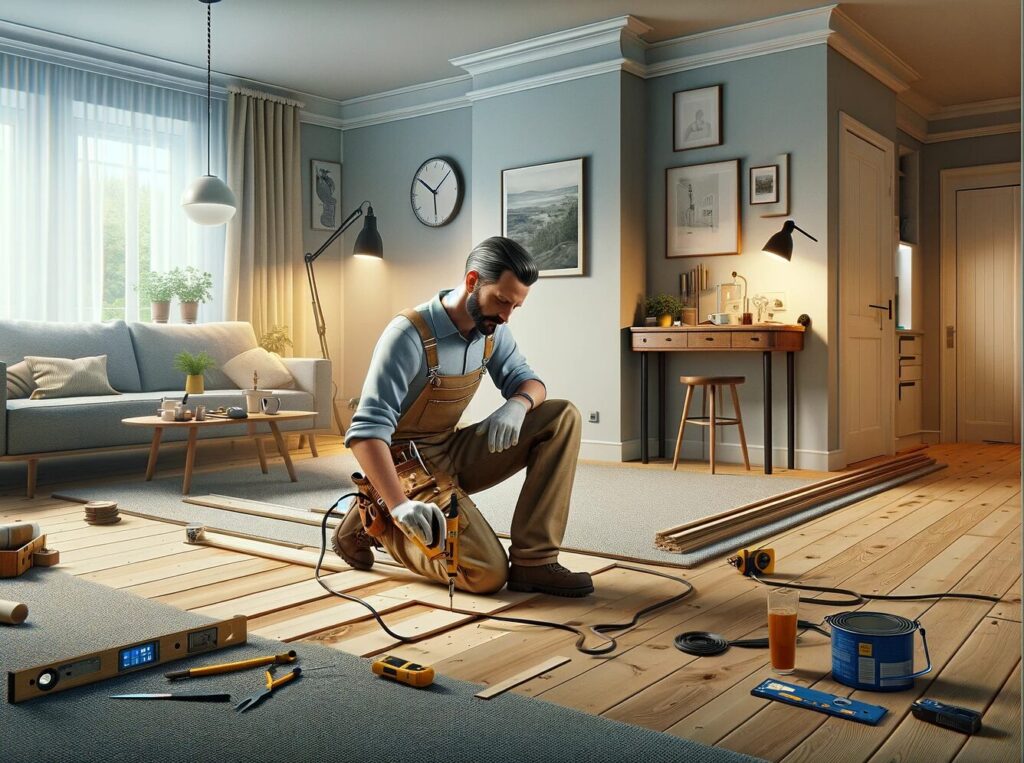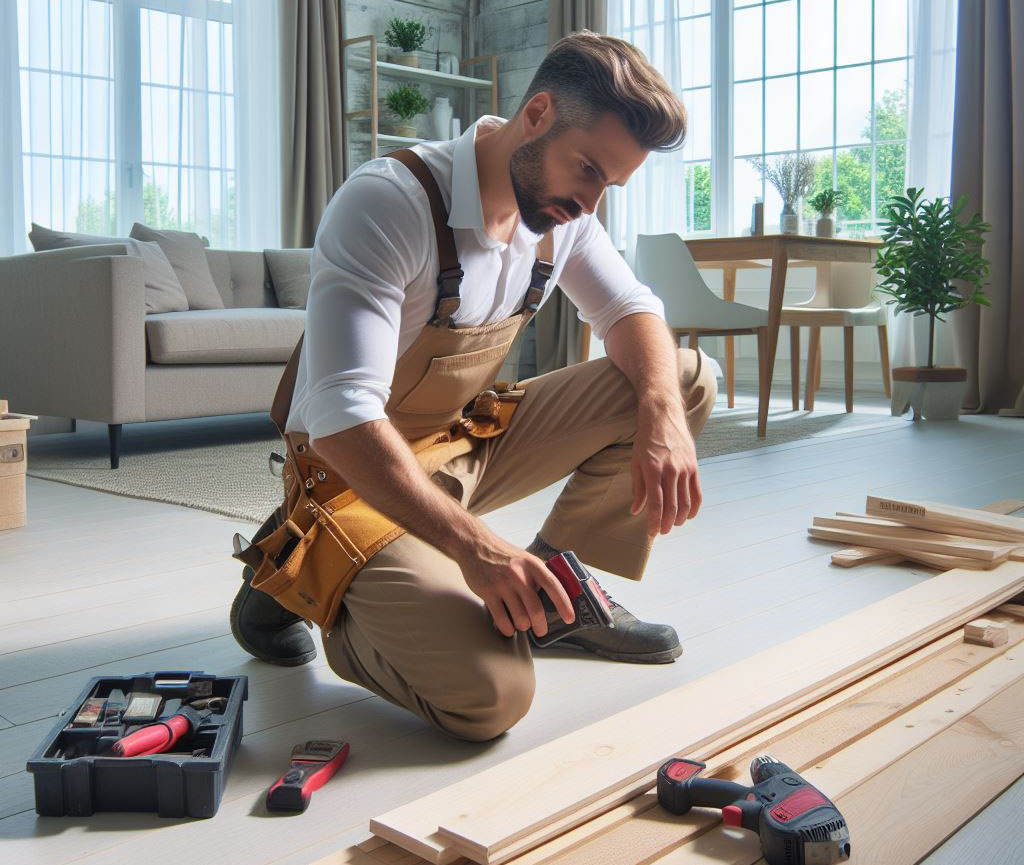In the ever-evolving landscape of home renovation and construction, one commonly encountered adversary is the squeaky floor. It’s a ubiquitous issue that plagues both old and new homes alike, often causing annoyance and frustration. Yet, the resolution to this problem lies within reach of even the most novice DIY enthusiast. With a clear, step-by-step approach, you’ll find that rectifying a squeaky floor is not only manageable but also quite satisfying.

Identifying the Cause
Understanding the root of the problem is crucial. A squeaky floor is often a sign of an ongoing tussle between various elements of your flooring structure. Here are some usual suspects:
- Loose Boards: Over time, the natural ebb and flow of home life can cause floorboards to loosen. As they shift, they might rub against nails or each other, resulting in that telltale squeak.
- Dry or Aged Wood: Wood is an organic, dynamic material. It reacts to changes in humidity and temperature, sometimes causing it to shrink or expand. This can lead to gaps and friction, and thus noise.
- Subfloor Issues: Often overlooked, the subfloor can be the true instigator. A loosened subfloor can move against floor joists, creating a chorus of creaks and squeaks.
Locating the Squeak
- Visual Inspection: A thorough visual examination can often reveal gaps or signs of wear that might be causing the noise.
- The Step Test: Methodically walking over the area and marking the noisy spots is a practical way to isolate the issue.
- Underneath Access: If possible, inspecting the floor from below (such as from a basement or crawl space) while someone walks above can provide invaluable insight into the exact problem areas.
Preparation and Safety
- Tool Assembly: Essential tools for this task include basics like a hammer, drill, appropriate screws or nails, a stud finder, and, for carpeted areas, a carpet knife and staple gun.
- Material Selection: Choose materials wisely. Specific tasks may require particular types of screws, wood filler, or lubricants like powdered graphite or talcum powder to address friction.
- Prioritizing Safety: Safety is paramount. Equip yourself with protective eyewear, gloves, and sturdy footwear. Ensure your workspace is free from hazards that could cause trips or falls.
Each step, when approached with patience and attention to detail, leads you closer to a silent, squeak-free floor. Let’s proceed, armed with the right tools and knowledge, to tackle each specific repair scenario in the upcoming sections.
Step-by-Step Repair Guides
For Squeaky Wood Floors:
- Tightening Loose Floorboards:
- Identify the Offenders: Locate those loose boards that have been causing all the racket. A good indication is a floorboard that moves underfoot.
- Steady Fixing: Use trim-head screws for a discreet yet effective fix. Drill pilot holes to avoid splitting the wood and screw them into the joists. It’s a simple yet effective technique.
- Nailing It Down: If screws aren’t an option, angle finishing nails into the tongues of the boards. This traditional method still holds its own in providing a secure fit.
- Lubricating the Floorboards:
- Quieting with Powder: A little talcum powder or graphite in the joints can work wonders in reducing friction. It’s a quick, old-school trick that often does the trick.
- Settle It In: Walk over the treated area. This helps the powder to penetrate the joints, reducing squeaks effectively.
- Using Screws or Nails:
- Screws Over Nails: Screws tend to provide a more lasting solution than nails. Find those joists with a stud finder and drive the screws in at an angle for a firm hold.
- Conceal Your Tracks: After securing with screws, fill the top with wood putty to hide the repair. A little sanding, and it’s as good as new.

For Squeaky Carpeted Floors:
- Locating Under-Carpet Squeaks:
- The Squeak Hunt: Use your ears and feet to find those squeaky spots under the carpet. It’s a bit like playing detective in your own home.
- Joist Finding: A thin nail or a stud finder is essential to locate the joists beneath the carpet, guiding you to the right spot for your fix.
- Fixing Without Carpet Damage:
- The Magic of Breakaway Screws: These specialized screws are a boon for carpeted floors. They dive through the carpet without causing damage and break off below the surface.
- Carpet Care: A little soap along the screw’s path can help it glide through the carpet fibers without causing snags.
For Squeaky Hardwood Floors:
- Preserving the Finish:
- Gentle Approach: Hardwood floors require a soft touch, especially when it comes to maintaining their finish.
- Matching Filler: Should drilling be necessary, choose a wood filler that matches your floor’s finish. It’s about making the repair invisible.
- Fixing the Squeaks:
- Pre-drilling Is Key: Always start with a pilot hole when dealing with hardwood. It’s a safeguard against splitting.
- Nail It Right: Insert finishing nails at an angle into the joists for a firm hold. This old-school technique is often the best approach.
- Blend It In: After nailing, use your color-matched wood filler to conceal the repair, followed by a gentle sanding. It’s about making the fix as seamless as possible.
Advanced Tips
- Addressing Underlying Structural Issues:
- In the realm of home renovation, it’s essential to look beyond surface problems. When dealing with squeaky floors, this often means examining the structural integrity of your floor joists and subflooring. Sagging beams or joists losing their integrity can be indicative of deeper issues.
- Reinforcing joists, a process often referred to as ‘sistering,’ involves affixing a new joist alongside the existing one, providing additional support. In cases of extensive damage, replacing sections of the subfloor or joists may be necessary. This level of repair ensures not just a quiet floor, but a safe one too.
- When to Seek Professional Help:
- Recognizing when a problem is beyond your expertise is a vital skill in home renovation. If your floor shows signs of significant wear, such as severe bending or cracking, or if your DIY attempts have been unsuccessful, it’s prudent to consult a professional.
- Homes with historical value or floors made of specialized materials, like exotic hardwoods, often require the touch of a seasoned expert. Consulting a professional in these cases can be a wise investment, safeguarding the unique aspects of your home.
FAQ Section:
Yes, you can. There are specialized breakaway screws designed for this very purpose. These screws can be driven through the carpet and into the subfloor and joist beneath. Once tightened, the top portion of the screw breaks off, remaining concealed under the carpet.
Typically, the culprit behind squeaky floors is movement. This can be movement between the floorboards themselves or between the floorboards and the subfloor layers. Often, this movement results from wood rubbing against wood or loosening of the nails over time.
Indeed, there are. A temporary and quick fix can involve the use of talcum powder, baby powder, or a dry lubricant. These substances can be applied to the area where the squeak is occurring to reduce friction and provide temporary relief from the noise.
No, complete floor replacement is rarely necessary for fixing squeaks. More often than not, targeted repairs such as securing loose boards or using shims can effectively address the issue without the need for extensive replacement.
Preventive maintenance is key to avoiding future squeaks. Maintaining stable humidity levels in your home is crucial, as excessive moisture can cause wood to swell, and a lack thereof can lead to shrinking, both conditions fostering squeaks. Periodic inspections and tightening of floorboards can also help in preventing the onset of squeaks.
